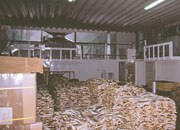
There, a handful of fisheries dried North Atlantic cod by sunlight. But that was before a consulting engineer used hvac technology to improve the productivity, shipping schedules, and even the taste of the seafood.
The outdoor drying process takes about one week of sunshine with no rain, and production schedules were at the mercy of the weather. So Lelievre, Lelievre & Lemoignan (LLL) of Sainte-Therese-de-Gaspe decided to use two dehumidifiers from Dectron, Roswell, GA. The units are modifications of the company’s DA series. They supply dry air to racks of fresh cod in dual custom-fabricated sheet metal drying tunnels in LLL’s 100,000-sq-ft headquarters.
Consultant Jean-Guy Ferland of Le Groupe Prodapec Inc. of St. Jerome handled the specifications of the tunnels, air distribution design, and equipment.
The process is reported to reduce annual labor costs by up to 80%. Previously, the outdoor process required covering the fish every night and additional precautions during rainy periods. Excess sunlight can lessen product quality as well. If the sun is too hot, the fish can literally cook or retain moisture under the skin, which prevents even drying. The mechanical process is controlled to keep the low temperature at 68 degrees F. In summer, when ambient temperatures surpass 68 degrees, the dehumidifier is also used to cool the air.
One other alternative to outdoor drying briefly considered was use of a furnace. But that approach was ruled out because of the large amount of exhaust air that’s required. When the airflow absorbs moisture from the fish, half of the return air must be exhausted while the remaining half is mixed with dry outside air that requires additional heating. And in foggy or rainy conditions conventional furnaces and tunnels can’t operate because of high outdoor humidity levels. The use of dehumidification was considered a better alternative.
Once the fish are caught, they are split in half and soaked in a saltwater solution. The fish are then piled on pallets to begin the water elimination process. Then the fish are loaded on portable racks to go into the tunnel.
The dehumidifiers are controlled by a Dectron HT-800 microprocessor to provide three relative humidity stages ranging from 60% in the beginning to 25% at the end.
“Energy costs are constantly shifting because of the sensible heat ratio of the drier air throughout the cycle,” said Ferland. “Our calculations tell us that 1 kWh is required to remove 4.25 lb of moisture.”
The dehumidifier came with an additional coil that supplies free hot water for the facility’s cleaning needs. Excess heat from the mechanical process is recovered to heat the water that is stored in a glass-lined, steel tank.
“We are fulfilling orders more accurately than we ever have in our 20-year history because we can now depend on the product drying and being ready on a predetermined date,” said Rock Lelievre, LLL president. “The addition of state-of-the-art dehumidification equipment has improved our bottom line.”
Publication date: 02/11/2002

Report Abusive Comment